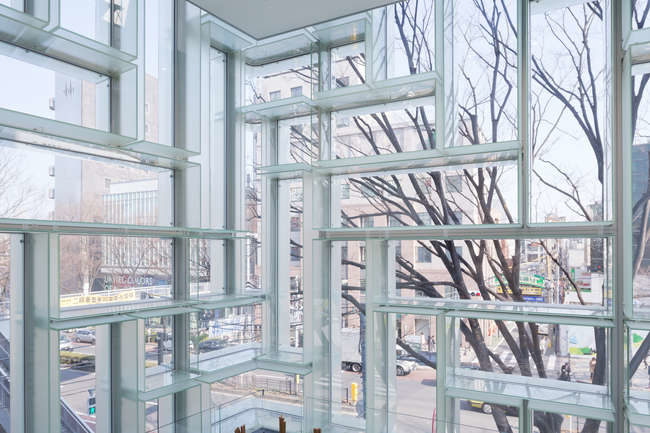Opened on April 4, Coach’s Omotesando Flagship shop is the latest addition to the stunning array of designer boutiques lining one of Tokyo’s most elegant shopping streets. Occupying a prime, corner site at the base of the new commercial complex Oak Omotesando, the shop interior was created by Coach’s in-house design team. But its standout visual features—an elegant, transparent façade and an internal stair tower—were designed by OMA New York. Composed of glass boxes arranged in a bold, herringbone pattern, the entire exterior surface doubles as display, enabling not just the brand, but also individual bags and boots, to have a presence on this famous street.
The façade’s design started with OMA’s Coach boutique inside Macy’s Herald Square headquarters in the heart of Manhattan. Oriented towards the store’s Broadway entrance, the shop-in-shop is defined by a 16-foot high, L-shaped display wall rendered in clear acrylic. “It looks like the Flatiron building within Macy’s,” jokes OMA partner-in-charge Shohei Shigematsu. For Tokyo, Shigematsu brought that urban-scaled interior element outside.
Naturally, the materials, construction, and composition had to be reconfigured for façade use. Oriented vertically and horizontally, the Omotesando units are six-by-two-feet—dimensions sized for Coach’s standard mannequins and merchandise. Though the boxes look stacked, steel frames secure them inconspicuously. Bolted to this structure and held together by silicone, seismic joints, each box is made of laminated, quarter-inch thick layers of glass, one clear and one frosted (it acts like a louver), plus insulated glass end panels that reduce heat gain.
Inside, the stair tower linking the women’s and men’s departments on the ground and second floor, respectively, echoes the façade. Positioned near the door for easy access, the marble treads are encased with transparent boxes containing more Coach offerings to entice customers as they ascend. Each box is made of laminated layers of glass and frosted acrylic with embedded LED lighting. “When the store lighting is turned off, the core can glow at night,” explains Shigematsu.
Concentrating the display areas on the vertical surfaces not only frees up floor space, it is also intended to encourage Coach personnel creativity. “One day they could show only shoes, one day only red things and on another day a single bag in multiple colors,” says Shigematsu. But the filtered backdrop of Omotesando’s tree-lined streetscape will enhance whatever they choose to present.














Post a comment to this article
Report Abusive Comment